Introduction: The human anatomy, or in brief, the body structure has fascinated man for ages. Due to the information explosion and the increase in specializations, this knowledge is available in a very sketchy manner in high school biology courses. The first comprehensive course on the human anatomy is taught to the first year medical students in medical colleges. This is in keeping with the regulations of the Medical Council of India. The anatomy lecture classes occupy a considerable time of the course, to provide the students with an effective knowledge of the gross anatomy, histology, embryology and the clinical anatomy. On the other hand, the students’ feedback regarding the lecture methods and the teaching environment is crucial in judging the efficacy of the present curriculum.
Objective: To obtain the students’ feedback about the environment of the lecture classes, as regards the venue, the teaching and learning aids which are used, the lecture class schedule of the university (the number of classes per week, the durations of the lecture classes, etc.) and the existing departmental practices (display of the class routine in advance, synchronization between the lecture and the practical classes), so that their suggestions could help the faculty in planning the most effective teaching procedures.
Methods: A semi structured questionnaire was supplied to the students to get their feedback.
Result: Most of the students found the air conditioned seminar room’s environment to be more comfortable and they supported the existing durations of the lecture hours with the combined use of chalk and a board and overhead projectors (OHPs).
Conclusion: The perceptions of the learners helped in modifying the departmental practice in the desired way.
INTRODUCTION
The first professional MBBS course is the first contact of the fresh medical students with the medical education system after completing the higher secondary (10+2) school or college level. So, this is a very crucial period for the medical students, in which they get accustomed to a different type of educational environment. Anatomy is one of the core subjects in the first professional MBBS course, which has the maximum number (almost 50%) of teaching hours. (the salient features of the regulations on the graduate medical education,1997which have been amended for up to February 2012) [1]. For the medical students and the aspiring doctors, the sudden transition from the higher secondary school or the college level to the medical college is rather difficult and stressful, and many students find it difficult to cope. This is more so, because India is a land of diversity and medical students come from different educational and socio economic backgrounds. To overcome these problems of orientation, the Medical Council of India (MCI), through the Regulations on Graduate Medical Education [2], proposed the introduction of a ‘foundation course’ for a period of two months, prior to a study of the preclinical subjects in Phase I MBBS. Through the foundation course, the MCI has laid stress on a gradual orientation in the core subjects, instead of abruptly starting the teaching of the core subjects from the very first day. Thirdly, the concept of the medical curriculum is also getting changed from a teacher based module to a learner based module. So, it is the need of the hour to assess the feedback from the students regarding the existing system of the anatomy teaching, to modify it according to their needs.
Like all other medical colleges of West Bengal, in the North Bengal Medical College, India which is recognized by the MCI with an annual intake of 100 MBBS students, lectures still remain the most common mode of large group teaching in medical education. Students learn from the lectures by listening,observing, summarizing and through note taking (Brown and Manogue [3]. According to the MCI guidelines, though lectures should not occupy more than 1/3rd of the teaching hours in the MBBS course, their importance cannot be ignored. Sometimes, understanding is achieved during a lecture and sometimes it emerges when students pore over their notes after a lecture. Lectures can be supplemented with audiovisual aids for better illustrations, clarity and learning (Brown and Manogue [3]; Brill and Galloway [4].
The capacity of a lecture hall is typically measured in hundreds. Lecture halls should have a pitched floor (Lecture theatre. The minimum standard requirements for a medical college for 100 admissions, Annual Regulations, 1999, Medical Council of India) [5], so that those in the rear are seated higher than those at the front, allowing them to see the lecturer. Lecture halls are excellent for focusing the attention of a large group on a single point, either an instructor or an audio-visual presentation, and the modern lecture halls often feature audio-visual equipment. A microphone and loudspeakers are commonly used for helping the lecturer to be heard, and projection screens may be used for large displays. In addition, the acoustic properties of the lecture halls are definitely helpful for the listeners. The MCI guidelines have emphasized on the use of modern technologies of teaching by the faculty members. The MCI guidelines have allotted about ½ the time period for Human Anatomy and ½ the time is allotted for Physiology and Biochemistry for Phase I MBBS (which comprises of the 1st and the 2nd semesters).
The conventional routine which has been introduced by the West Bengal University of Health Sciences for the 1st and 2nd semester students (Rules, Regulations and Syllabus for the First Professional MBBS course of West Bengal University of Health Sciences) [6] requires six anatomy lecture classes per weeek, which start at 9 am or 10 am on alternative days (Mon-Sat). It does not allow breaks or intervals in between two lecture classes, but it gives a one hour lunch break at noon.
In North Bengal Medical College, there are two venues for the anatomy lecture- one is the lecture theatre (LT) with a capacity of seating 130 students and a large departmental air-conditioned seminar room (ACSR) with a capacity of seating 80 students. Unlike the lecture theatre, the seminar room does not possess a slanting floor but it is provided with air conditioner machines. Modern teaching aids like an over head projector, an LCD projector and laptops are available in the lecture classes, in addition to black-boards and chalk. As is practised in the department, the topics of the lecture classes get displayed to the students, one month in advance, in a format of class-routine, which maintains a correlation with the practical classes.
A record of attendance is required for allowing a student to appear for the university examinations. This is regularly practised in every lecture and practical class, though it is time consuming and takes a large share of the allotted teaching hours. Traditionally, the lectures are usually delivered in English. In recent times, as a part of the Foundation course, MCI has given more emphasis on language classes for English as well as for the local languages, in the Revised Guidelines for Graduate Medical Education 2012. A study which was done by Swadi in [7] supported the fact that effective communication skills depend on the fluency in English. Another study which was done in Bangladesh also noted that most of the students faced considerable difficulty with English as a medium of instruction for Anatomy (Hossain et al.,) [8]. Sometimes, sudden tests are held as a part of the continuous assessment.
Course assessment instruments such as feedbacks, help the faculty in identifying the strengths and the weaknesses of their teaching and evaluation methods (Ruth, [9]; Ritchardson, [10]. Currently, the student’s feedback represents the primary means which is used by most of the programmes to assess their methodologies (Victoroff and Hogan) [11]. Different studies in the form of the students’ feedback evaluation for the improvement of the teaching- learning methods for modifying the curriculum, have been undertaken in so many streams of the medical education.
The present study which was done in the Department of Anatomy, North Bengal Medical College, India was unique, as it involved the Phase I MBBS students who were newcomers in the field of medical education. They were still in the process of the adaptation to a new environment, which was related to the subject of Anatomy, which occupied the maximum period of time, in comparison to the other subjects in the Phase I MBBS course. This study was carried out at a time when MCI had already outlined a foundation course after realizing the need for a modification of the curriculum.
OBJECTIVES
The present study was aimed at assessing the feedback from the first professional MBBS students regarding.
The preference of the venue of the lecture class on the basis of their comfort.
The preference of the teaching-learning aids.
University routine regarding the timing of the lecture classes and the breaks between the two lectures.
Departmental practices, especially an advanced display of the lecture class schedule, parity of the lecture topics with the practical classes, attendance recording, sudden class tests, and the lecture oration in the English language.
METHODOLOGY
The present study was carried out in the Department of Anatomy of North Bengal Medical College, a medical teaching institute which is affiliated to the West Bengal University of Health Sciences. The subject population was the entire batch of the 1st Prof MBBS students of the session 2011-12, just before they had appeared for their university examinations. These students had been exposed to one year of Anatomy classes and so, were in the best position to judge the teaching practices of the institution. Proper permission from the Institutional Ethics Committee and the Head of the Department were obtained prior to the start of the study. A prevalidated semi-structured questionnaire was provided to all the students of the batch on the day of the form-fill up for the university examination, to ensure maximum participation.
The proforma had three main sections. The first section contained general information of the subjects like age, sex, pre-medical qualifying exam, residence, the class XII learning medium, etc. The approximate monthly family income and the number of family members were also enquired about, to get an idea about their socio-economic statuses, by calculation with the help of the modified Prasad’s scale. The second section dealt with a two point scoring system (below satisfactory and above satisfactory) for six parameters which explored the comfort of the lecture venue. The parameters were accommodation, black-board visibility from the last bench, lighting, teacher audibility from the last bench, ventilation and the temperature-cum-humidity control. The third section was the single best response type multiple choice questions on the preference of the teaching media, lecture hours/day, lecture classes/week, timing of the lecture classes, breaks between the lecture classes, notification of the class routine in advance, parity of the lecture topics with the practical classes, the utility of taking class notes, attendance records and sudden tests, as well as the language problems in the lecture classes, if any. At the end of this section, an open ended question was also placed, to record their suggestions.
The students were directed to fill up the questionnaire within a stipulated time, independently and in an unbiased manner, without mentioning their names or roll numbers. The completed response sheets were collected and the data which was collected was analyzed with the help of the SPSS software, version [12].
RESULTS
Among a total of 98 respondents, 69 were males and 29 were females. 36.7% of the students were admitted to the MBBS course after they had cleared the Pre Medical Examinations in the first attempt, while a majority (56.1%) were admitted after they had qualified after a second attempt. 7.1% students got through in the third attempt at the entrance examination. 87% students were admitted through the West Bengal State Joint Entrance Examination, and 13% were admitted through the “All India” quota. Almost one-third of the students were from the reserved category. A large share of the students were from urban areas (60%), whereas 22.4% were from villages and only 17.3% were from large cities. 93.9% belonged to high socioeconomic statuses, 3% were from the middle class and 3.1% were from low socioeconomic groups.
As far as the comfort and the suitability of the lecture venues were concerned, 77.5% students commented that the accommodation was above satisfactory in the lecture theatre (LT), whereas 68.3% remarked that it was below satisfactory in the air conditioned seminar room (ACSR). 77.5% students informed that the black board was hard to see from the last bench in the ACSR, whereas only 53.1% were satisfied about it in the LT. 53.1% students opined that the teacher was audible from the last bench in the LT, but a larger proportion of the students (63.2%) opined that it was better in the ACSR.
In both the venues, the lighting arrangement was above satisfactory for a larger portion of the students (almost 83.7% opined about this with respect to the LT, and 87.8% opined about it with respect to the ACSR). A greater portion of the students was satisfied with the ventilation as well as temperature-cum-humidity control in the ACSR than with those in the LT. So, the overall comfort was better in the seminar hall, though the accommodation was quite limited there [Table/Fig-1].
Horizontal stacked bar diagram reflecting students’ feedback regarding the comfort of lecture venues [LT=Lecture theatre; ACSR=Air conditioned seminar room]
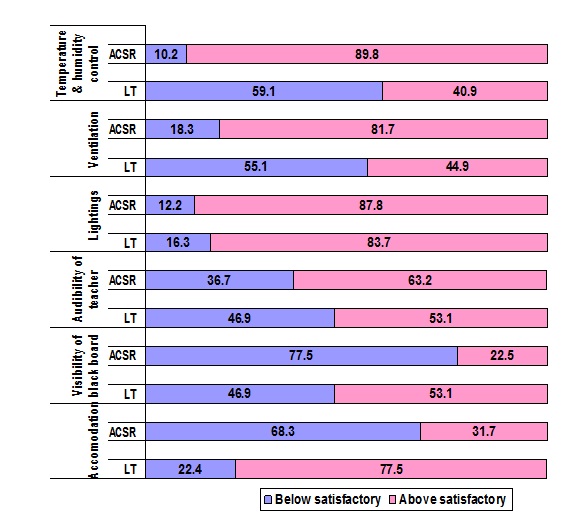
Over head projectors and transparency sheets in association with boards and chalk was preferred by almost 46.94% of the students, whereas 23.47% preferred the use of laptops-cum-LCD projectors which were associated with boards- and chalk. Only chalk and boards teaching was preferred by almost 29.59% of the students [Table/Fig-2].
Pie chart depicting the students’ feedback on preference for teaching aids
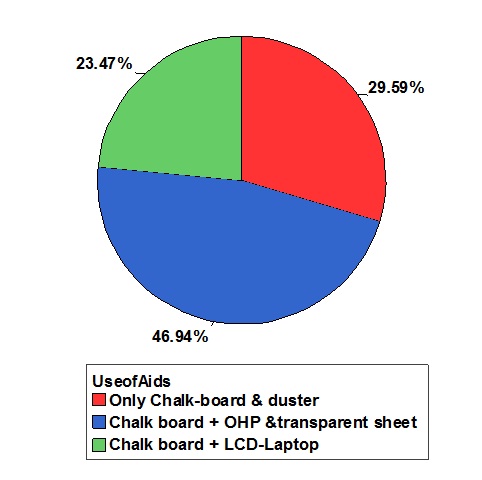
64% of the students used to take class notes regularly, as it appeared helpful to them. 35% students took them off and on. 1% of the students did not rely on class notes and they did not take them down [Table/Fig-3].
Bar diagram depicting the students’ feedback on utility of class notes
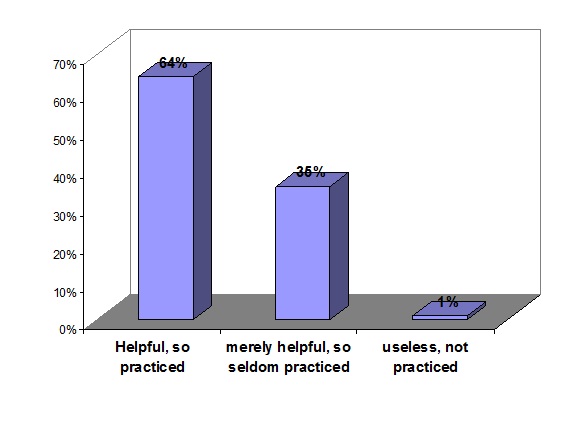
A majority (79.6%) of the students pointed out the necessity of taking attendance in every class hour, whereas it was reported to be totally useless by 3.1% of the students. The rest of them opined that it could be recorded once a day. Almost 91.8% students supported the practice of sudden class tests, as it appeared to be helpful for their examination preparation, though for 1%, it is totally useless. The rest of the 7.2% commented that it could be merely helpful in studies [Table/Fig-4].
Frequency distribution table on students’ feedback on various departmental practices
| Parameters | Response |
|---|
| Essentiality of attendance record | Extremely essential, so to be practised in each class 79.6% | Merely helpful, can be taken once a day 17.3% | Useless, only time consuming 3.1% |
| Utility of sudden class test | Essential, guides for exam preparation 91.8% | Merely helpful 7.2% | Useless, only time consuming 1% |
| Per day lecture hour | One hr is sufficient 74.5% | To be increased 24.5% | To be decreased 1.0% |
| Lecture class per week | Six is sufficient 61.2% | To be increased 2.1% | To be decreased 36 36.7% |
| Timingof lecture class | Morning at 10am 79.6% | Morning at 9am 16.3% | Afternoon 4.1% |
| Breaks between twolecture | Not necessary 18.4% | Optional 12.2% | Necessary 69.4% |
| Advanced display of class routine | Helpful 100% | Merely helpful 0% | Not helpful 0% |
| Parity of lecture and practical topics | Helpful 100% | Merely helpful 0% | Not helpful 0% |
Almost two-third of the students faced a difficulty in understanding the lectures due to their delivery in the English language. 44.90% students believed this could be due to their 10+2 standard studies which they had done in the Bengali medium. But 22.45% students blamed the fluency of the orator [Table/Fig-5].
Pie diagram depicting the students’ feedback on ‘Language problem’ that occurs in lecture delivery in English language’
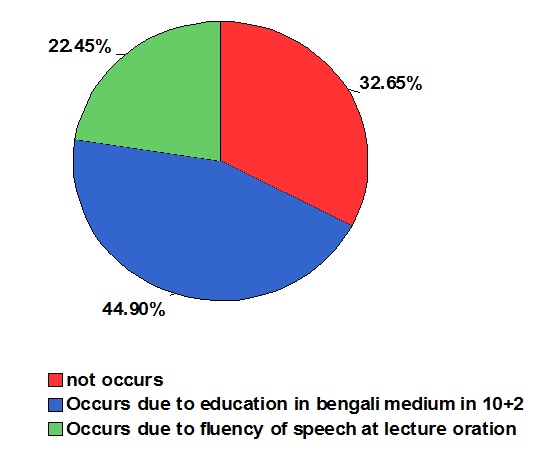
The most frequent suggestion was to supply study material (38.9%) [Table/Fig-6].
Representation of students’ suggestions (best choice options) [N= 98] Figures indicates percentages of response regarding students suggestions, where majority of the students expressed the requirement of study modules (38.9%) followed by small group learning (25.7%)
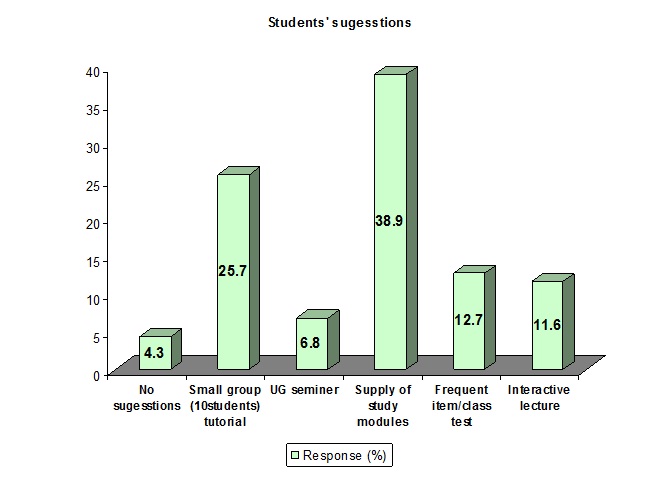
DISCUSSION
Bilateral participation and enthusiasm from both the students’ and the teachers’ sides are needed to make the lecture classes a grand success. In addition, a good atmosphere at the lecture hall, a comfortable temperature and appropriate light and a properly audible sound system are also required. So the students’ feedback on various parameters like the lecture theatre, the necessity of any audio-visual aids, the frequency of the lecture classes and their durations and timings, correlation of the lecture topics and the practical classes, etc. may help the faculty members in improving their efficacy and the students’ performances. Hence, the faculty members of the Department of Anatomy, NBMC and H, W.B. arranged a cross sectional, questionnaire- format based study on a population of phase I MBBS students of this institution. We also wanted to know whether the students preferred taking class notes and appearing for sudden tests. We also asked their perceptions regarding a prior intimation about the classes, the breaks between classes and taking attendance during each lecture class. We tried to find out whether they suffered from any language problem in the lecture classes and the reason behind it. A two-point scale was used (above satisfaction and below satisfaction) to collect information regarding the comfort in the lecture venues and to compare the two venues of the lecture classes for this subject i.e. the lecture theatre (LT) and the air conditioned seminar room (ACSR) [Table/Fig-1]. A majority of the students (77.5%) opined that the accommodation in the LT was above satisfactory, whereas only 31.7% declared it to be above satisfactory in the ACSR. Hence, from the view of the accommodation only, the LT was preferred above the ACSR. Regarding the view of the blackboard from the last bench in the LT, 77.5% responses were above satisfactory, whereas only 22.5% students regarded it to be above satisfactory in the ACSR. This reflects the effectiveness of the slanting pitch of the LT. As far as the light was concerned, both the LT and ACSR showed equivalent conditions (87.8% and 83.7% students commented it to be above satisfactory in the ACSR and in the LT respectively). The artificial ventilation of the ACSR was much more preferred than the cross ventilation of the LT, because 81.7% of the learners were satisfied in the ACSR as compared to only 44.9% in the LT. A greater portion of the students was satisfied with the ventilation as well as the temperature-cum-humidity control in the ACSR (89.8%) than in the LT (40.9%). 53.1% of the students opined that the teacher was audible from the last bench in the LT, but a larger proportion of students (63.2%) opined that it is better in the ACSR. This finding can be explained by the sound proof environment of the ACSR. So, the overall comfort was better in the ACSR, though the accommodation was quiet limited there.
This study revealed that 29.59% responses were in favour of the use of only chalk and boards, whereas 46.94% supported the judicious use of both the chalk and boards and OHPs with transparent sheets [Table/Fig-2]. Though in another study, a majority of the students elicited the judicious use of chalk and boards with OHPs or power point presentations (Bhowmick et al.,) [12] the findings of the present study revealed that the students felt that the explanation, clarity of the concepts , learning to draw diagrams, etc were better with the use of chalk and boards. According to Novelli and Fernandes [13] also, traditional classes with blackboard presentations were mostly favoured by the students in the biomedicine and the medicine courses. With chalkboard teaching, the lectures are clear and understandable, they stimulate the students’ interests and encourage their participations, and the students are able to make their notes/diagrams. Also, the teachers find flexibility with the chalk and boards, to amplify a particular point. Another reason for liking the chalk and boards is that power failures cannot interrupt the lectures and as the students are encouraged in taking down the notes and diagrams, as the students follow the hands of the teachers and as the lectures contain natural pauses and breaks. Only 23.47% of the students liked power point presentations. The reason behind this may be that sometimes too many slides are packed into a 60 minutes class or the students may not find the difference between power point presentations and text book reading. The reason for not liking the OHPs or the power point presentations may be their dependence on electricity. Another reason may be that even the best of diagrams on power point presentations cannot be copied, whereas, any diagrams/illustrations on the blackboards can be copied, and it is this process that helps the students in learning as well as to in giving proper illustrations in their descriptive answers during examinations. Another point is that all the sections of the explanation are visible on the black board at a time, but this may not be the case with a power point presentation, where, if the student had’nt got a particular point when the slide was up, he/she would be left foundering. This can be problematic if the later points of the lecture depend on the understanding of the earlier points. This is why most of the students did not like power point presentations. So, the faculty members have to be more cautious regarding the mode of the delivery and the selection of the teaching learning aid, which should be dependent on the topic.
The next point was to elicit the opinion of the students regarding note taking. Note taking in the class facilitates a better recall, which in turn, helps in learning the subject better (Abraham et al.,) [14]. Another advantage of taking down notes in the class is that it prevents distraction and helps in focusing on the topic. The present study also revealed the importance of note taking in the class, as 64% students declared it to be helpful [Table/Fig-3].
A majority of the learners realized the importance of maintaining a record of the attendance, which was outlined by the MCI, as 79.6% respondents perceived the practice of taking attendance in each and every class to be mandatory and 17.3% declared that the attendance should be taken only once daily, as it was time consuming [Table/Fig-4]. The MCI has given immense emphasis on a continuous assessment and this view was also evident in the present study, as 91.8% learners declared the sudden tests to be beneficial for the preparation for the examination and as 7.2% mentioned that they were merely helpful [Table/Fig-4]. Most probably, the students are inspired to study continuously, to appear for the sudden tests and also to get the chance for a rectification in the periodical or university examinations.
The next point was the duration of the lecture class hours. A majority of the students (74.5%) considered that the present MCI recommendation and practice of a lecture class of one hour’s duration was sufficient. Only 24.5% learners felt the necessity of more than a one hour duration of the lecture class [Table/Fig-4]. Though one study elicited the suggestion of a reduced lecture class duration, the present study failed to show any such opinion, as only a negligible number of respondents opted for this (Prakash et al.,) [15]. Another research revealed that 45 minutes or even 30 minutes was an ideal lecture period (Hashmi et al., [16], Goyal M. et al., [17]. The maximum number of students needed 6 lecture classes in this subject per week, as is being practised presently. The second highest response in this regards was [4]. Hence, it may be concluded, that to complete the whole syllabus in the stipulated time period, the students may have opted for the maximum possible number (i.e. 6 lecture classes per week) and duration (1 hour) of the classes, as to concentrate for more than one hour was difficult. 78% students preferred the lecture class timing of 10 am, whereas 16% preferred the lecture class timing of 9 a.m. This view can be supported by the fact that the ability to concentrate is usually better in the early part of the day. The present study supported the necessity of a short interval between two successive lecture classes, as 68% of the student participants were in favour of a 10 minute break between two lecture classes and as 18% were in favour of no interval. According to Lata H et al., [18] the students preferred 10 minute tea breaks rather than a 1 hour lunch break and shorter total teaching-learning sessions, to get more time for self study. All the learners supported the present practice of correlating the lecture and the demonstration class schedules. Obviously, this is helpful for the students for a better understanding and conceptualization of the topic. All the students opined that a prior intimation of the class routine would be beneficial.
One study in Bangladesh elicited the considerable difficulty of the undergraduate medical students, as the lectures were conducted in the English language in Anatomy (Hossain et al.,) [8]. In the present study also, 44.90% students expressed that there was a problem in understanding the language in the lecture classes, as they belonged to the Bengali medium (they had studied in the Bengali medium at the 10+2 level), but 22.45% experienced a language problem due to the fluency of speech of the teachers [Table/Fig-5].
The three most frequent suggestions were, a supply of study material (38.9%), small group (comprising 10 students) tutorials (25.7%) and frequent item or class tests (12.7%) [Table/Fig-6]. The necessity of the supply of study material, small batch tutorial are again in favour of individualised care based environment which is hoped to be changed at the end of the phase I towards institution based education. The other suggestions for an improvement in the lecture classes were interactive lecture classes and undergraduate seminars.
It can be concluded from this study, that the perceptions of the students with regards to the prevailing system of lecture classes has facilitated a change in the attitude and the practice of the faculty members in the desired direction, which will help a better conceptualization of the subject, improved performances of the students and the learners adapting gradually with the institution based care in the modern medical education in India.
[1]. Salient features of regulations on graduate medical education, 1997 (amended upto february-2012)[online] available at http://www.mciindia.org [accessed on 01.07.2012] [Google Scholar]
[2]. Regulations on graduate medical education 2012 available at http://www.mciindia.org [accessed on 01.07.2012] [Google Scholar]
[3]. Brown G, Manogue M, AMEE Medical Education Guide No.22: Refreshing lecturing: a guide for lecturerMedical Teacher 2001 23(3):231-44. [Google Scholar]
[4]. Brill J.M, Galloway C, Perils and Promises:University Instructors Integration of Technology in Classroom- Based PracticesBritish Journal of Educational Technology 2007 38:95-105. [Google Scholar]
[5]. Lecture theatre. Minimum Standard Requirements For The Medical College For 100 Admissions Annually Regulations, 1999. As per the terms of Notification published on 02.12.2008 in the Gazette of India.Medical Council of India. Available in website http://www.mciindia.org/forcolleges/Minimum%20Standard%20Requirements%20for%20100%20 Admissions.pdf/downloads. page no.8 [accessed on 23 Jun 2012] [Google Scholar]
[6]. Proposed Routine of 1st Prof. MBBS Course For 100 Annual Admissions. Rules, Regulations and Syllabus for First Professional MBBS course of West Bengal University of Health Sciences. Available at website http//:www.wbuhs.ac.in/pages/regulations.html.downloads; page no. 6 [accessed on 23 Jun 2012] [Google Scholar]
[7]. Swadi H, The impact of primary language on the performance of medical undergraduates in communication skillsInforma Healthcare 1997 19(4):270-74. [Google Scholar]
[8]. Hossain S, Shamim KM, Shahana N, Habib MA, Rahman A, Is English as a Medium of Instruction Problem for Undergraduate Medical Students?Journal of Armed Forces Medical College, Bangladesh 2010 6(2):32-36. [Google Scholar]
[9]. Ruth N, Communicating student evaluation of teaching results: rating interpretation guides (RIGs)Assessment and Evaluation in Higher Education 2000 25:121-34. [Google Scholar]
[10]. Richardson BK, FeedbackAcademic Emergency Medicine 2004 11:1-5. [Google Scholar]
[11]. Victoroff KZ, Hogan S, Students’perceptions of effective learning experiences in dental school: a qualitative study using a critical incident techniqueJournal of Dental Education 2006 70:124-32. [Google Scholar]
[12]. Bhowmick K, Mukhopadhyay M, Chakraborty S, Sen PK, Chakraborty I, Assessment of perception of first professional MBBS students in India about a teaching learning activity in BiochemistrySouth East Asian Journal of Medical Education 2009 3(2):27-34. [Google Scholar]
[13]. Novelli ELB, Fernandes AAH, Students’ preferred teaching techniques for biochemistry in biomedicine and medicine coursesBiochem. Mol. Biol. Edu 2007 35:263-66. [Google Scholar]
[14]. Abraham RR, Kamath S, Ramnarayan K, Impact of note-taking on cognition during lecturesSouth East Asian Journal of Medical Education 2010 4(2):44-45. [Google Scholar]
[15]. Prakash C, Srivastava B, Gaur S, Sinha AK, Novel Ideas and Approaches to Learning Medical SciencesJ Indian Acad Forensic Med 2010 32(2):124-27. [Google Scholar]
[16]. Hashmi NR, Daud S, Manzoor I, Medical education: views and recommendations by final year MBBS students of a private medical college in LahoreJ Coll Physicians Surg Pak 2010 20(2):93-7. [Google Scholar]
[17]. Goyal M, Bansal M, Gupta A, Yadav S, Perceptions and suggestions of 2nd professional MBBS students about their teaching and learning process: An analytical studyNJIRM 2010 1(4):20-24. [Google Scholar]
[18]. Lata H, Walia L, Gupta V, Student feedback on teaching and evaluation methodologyin physiologySouth East Asian Journal of Medical Education 2008 2(1):31-7. [Google Scholar]